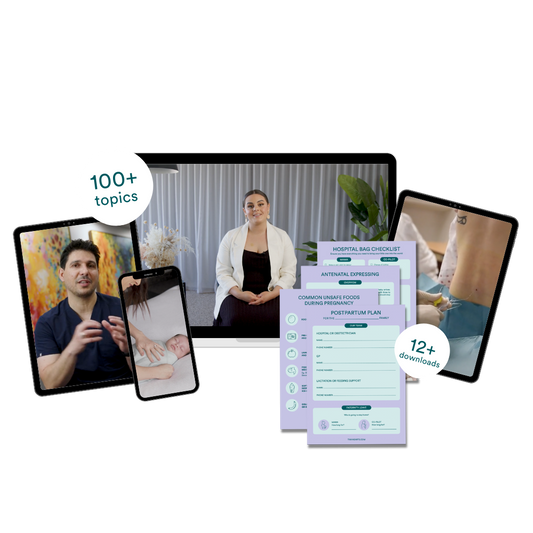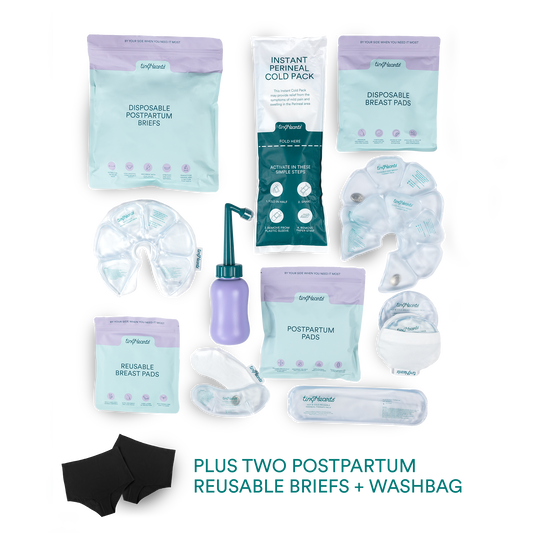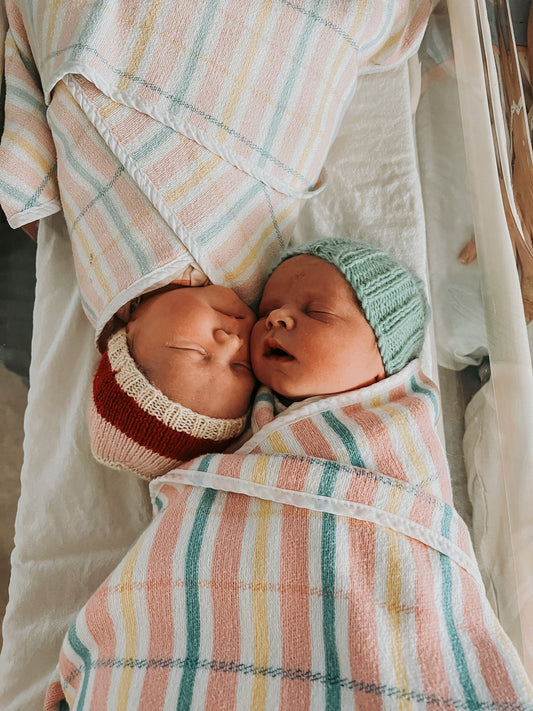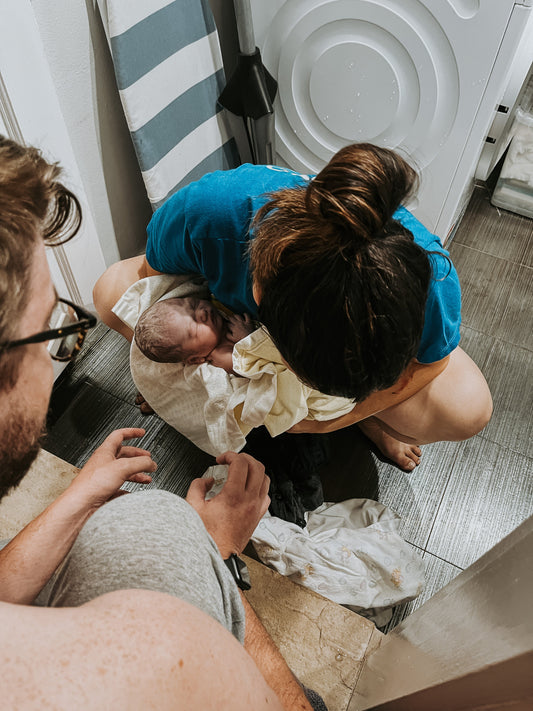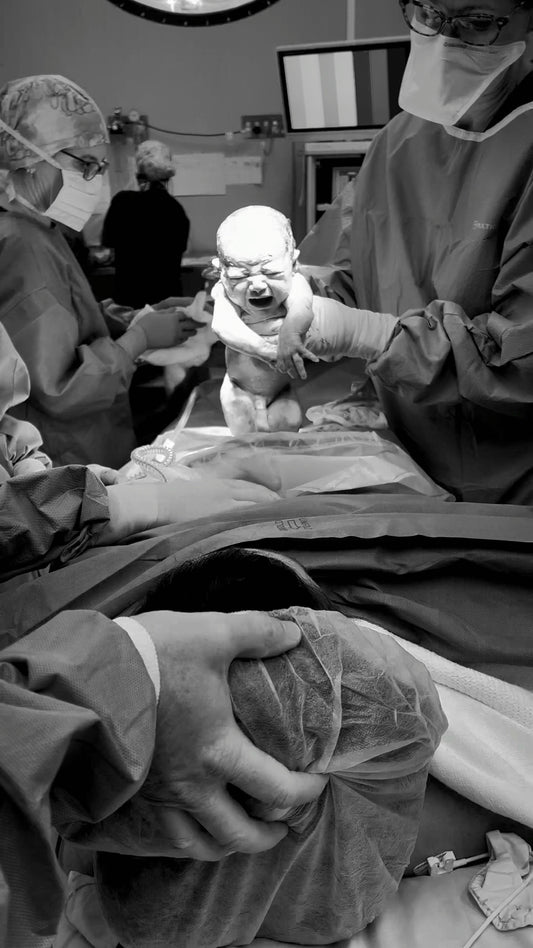Christmas Safety Tips
Heading into the festive season, there's already lots to worry about, but your little one's safety doesn't have to be one of them. We've written this blog as a way to help you identify, prevent + treat common safety hazards we hear of around this time of year, so you can focus on enjoying Christmas with your loved ones. ❤️💚
trampolines
Trampolines are the number one birthday or Christmas gift for 5 year olds!
Most of us would have memories as kids jumping on the trampoline, summer nights laying and looking at the stars and of course double bouncing our siblings.
But trampolines can be dangerous and thousands of kids are injured and hospitalised each year around Australia with serious injury. A Child Health Poll completed by the Royal Children’s Hospital found that although trampoline manufacturing companies have recommendations for safe use 80% of parents reported that that they allow more than one child to jump at once. With 1 in 5 parents are allowing 4 or more children on the trampoline at the same time which significantly increases the risk of injury.
The report also found that two thirds of children over four are not supervised and 20 percent of children under two are not supervised by an adult whist jumping. Toddlers and primary school aged children are the biggest jumpers with ages 2 - 6 year of age making up for 75% of those who use trampolines. Most parents reported that their trampoline has a safety net but there was no difference in the frequency or seriousness of trampoline related injuries among young children to those who didn't have a safety net.
Common injuries as a result of a trampoline accident:
- Broken bones
- Dislocations
- Dislodged teeth
- Head and Neck injury
- Sprains and Strains
- Cuts, grazes and bruising
With only 1 in 2 parents knowing the correct first aid treatment for injuries sustained on a trampoline its time to refresh not just your flip skills but knowing how to recognise and treat you child injuries! To avoid accidents on the trampoline use these steps:
-Only use trampolines fitted with a safety net and spring and frame pads.
- If the trampoline is exposed to the elements, regularly check for holes, rusting or other damage.
- Only one child at a time
- Supervise children at all times
- Don’t go underneath the mat
- No food while bouncing (aka choking hazard!)
- Teach your child to be careful when getting on and off the trampoline.
- Ensure that the area around the trampoline is free from hazards.
cHoking
Choking is when there is an object caught in a child's airway that blocks the airway, which makes it difficult or impossible to breathe. It either partially blocks the airway or completely blocks the airway. Anything that goes in your little one's mouth can be a choking hazard, but we know the most common hazards are round, firm or slippery; think grapes, cherry tomatoes, blueberries, nuts, raw carrot, apple, popcorn, marshmallows, chewing gums, coins, marbles, batteries and the list goes on. The greater the roundness, firmness or slipperiness of an object, the greater the choking risk.
To prevent choking, follow the "chop it, swap it or stop it" guide. The foods that cause the greatest choking risks should be altered to make them safer. For some examples, you can make food less round by cutting it; you should cut grapes in quarters, length ways, you can roll slippery food like avocado in fine breadcrumbs, cook carrot to make them softer or grate apples. If you can't alter them, swap them for something safer. For example, popcorn can't be altered, so swap it for corn puffs. If you can't modify it, or swap it for a safe alternative, stop the food altogether until bub is developmentally able to safely eat the food.
If bub has a partial obstruction, watch + wait, and call 000 if they can't clear it. If bub has a complete obstruction, call 000 immediately + spring into action with '5 to stay alive'. 5 back blows, followed by 5 chest thrusts. The tricky thing about Christmas is that with lots of family around, someone may give something to bub without you knowing. My best piece of advice is to make bub's eating restrictions known early on, but if your family still struggle with boundaries, arm yourself with the knowledge + skills of choking first aid. mbled it to make a type specimen book.
table cloths
Toddlers are naturally curious little people. They push on drawers. Draw on the walls. Climb furniture. And pull on things, even when they shouldn't. One of the things they pull on is tablecloths.
If you've just served your Christmas lunch, think about what could be on that table: Sharp knives, glass cups, ceramic plates, burning hot food, candles that are on fire, glass bottles, heavy dishes and hot liquids. Now think about what's going to happen if a toddler walks along and pulls the tablecloth down towards themselves. Yep, all of those hazards are going with it, straight towards your little one. Instead, this year we're going to use small heat mats and placemats and make sure everything is in the centre of the table, away from little hands. I know this isn't always possible for everyone, so instead, you could:
- Stack the food along the back of the kitchen bench instead of on the table
- Fold in the edges of the tablecloth and tuck them up and away
- Section off the table so Bub can't get there without help from an adult
- Substitute glass for plastic, silicone or bamboo products
- Substitute your tablecloth for small heat mats and placemats
Christmas is my favourite time of year. I love putting up the tree, decorating the house and serving Christmas lunch with the family. But with little ones around, a tablecloth just isn't worth having on the table.

button batteries
In Australia, one child a month is seriously injured after swallowing a button battery. Sometimes, you may not even realise your bub has swallowed one, so prevention is KEY. Button batteries can come in many things, some you wouldn't even think of, such as:
- Watches
- Light up costumes + shoes
- Flashing toys
- Toys that move
- Books + toys that make noises
- Musical cards
- Non-flame candles
Button batteries look small and harmless, but the damage they can cause in a short amount of time is horrific. When swallowed, button batteries cause life-threatening chemical reactions by the electrical current from the battery combining with saliva to make Sodium Hydroxide. To prevent this from happening:
- Checking props and toys that use batteries to make sure there aren't any button batteries
- Educate friends + family about avoiding buying toys that contain button batteries
- If you must use an object that contains a button battery, ensure it is screwed closed, the compartment can not come loose and inspect regularly
- Educate older kiddos on the dangers of these Keep items and loose batteries out of reach of children
- Dispose of button batteries immediately and safely
If you suspect bub has swallowed a button battery, take them to the Emergency Department immediately and contact Poisons Information Centre on 13 11 26 for assistance and further advice.
supervision
We've all heard the ‘I thought ‘insert name’ was watching her sentence. And this is usually after an accident has occurred.
When pilots take control of the aircraft they say ‘I now have control of the airplane or simply my airplane’ It’s said whenever control is transferred from one pilot to the other clearly establishing who has primary control and responsibility. As parents we should use this. Get in the habit, establish a sentence and use it every time the responsibility of your child is transferred to someone new. A verbal confirmation ensuring the safe and active supervision of your child. This is particularly important near any body of water. We use it at the beach, by our pool and in any new or busy area, particularly on Christmas when there are lots + lots of adults around, but none that may be supervising directly.
Say ‘I’m on watch,’ ‘my turn to watch’, ‘I’ve got them.’ Say whatever you want, but create a sentence and use it when supervision of your child is imperative. We say safety in numbers, but when it comes to little ones and noisey, busy, exciting environments, in numbers we can become complacent. Saying ‘I’M ON WATCH’ - will keep your little love safe. This is particulalry important if lots of people are coming and going on the day - where are little ones going to be when cars are reversing and pulling in? Who is responsible for making sure they are there before cars come + go? Accidents are so quick + car safety is so so important.
sparklers
Lots of families love to use sparklers at Christmas time. While they're beautiful to look at, Sparklers can be dangerous, especially for little ones. They can cause severe burns, damage the eyes and burn through clothing.
When held together, multiple sparklers have the potential to get so hot that the wire heats up and causes a burn. They can also bend back as they move down and burn the back of the hand too. But it doesn't always take multiple to do that; it can be caused by just one. Once they've reached the bottom and have burnt out, they stay hot for quite a while, leading to a further risk for burns by little ones picking them up or stepping on them accidentally.
It's best to avoid sparklers and swap them for something else, like glow sticks [for older kids] or ribbons on sticks.

drowning
In Australia, it's hot at Christmas time, so most of us end up around a body of water, whether that's a pool, a lake, the ocean or a blowup pool in the backyard. Did you know that 294 Australians drowned in Australia in the 2020/21 year? Or that kids under 5 are at the highest risk of accidental drowning?
What about the fact that drowning occurs in swimming pools only 52% of the time? And only 16% occurs in baths or spas? What about the remaining 32 percent? The remaining 32% of drowning occurs in drowning hazards you probably haven't considered,such as:
- Fish ponds
- Eskies of melted ice
- Pet water bowls
- Buckets
- Animal troughs
- Irrigation channels
- Rainwater tanks
Here are the things you can do to minimise the drowning risk to your little ones this Christmas [and all year round]:
- Store sink and bath plugs up high and out of reach, or inside the locked medicine cupboard Actively supervise the entire time when in the bath or shower
- Keep locks on the toilets
- Regularly check to make sure the pool gate is secure and closes properly
- Use a small dog water bowl that we fill up regularly instead of a big one
- Store all buckets and eskies upside down
- Store our fish tank up high and out of reach, even with a chair
- Educate kiddos on why it's important not to enter the pool alone
- Know baby + child CPR and what to do in the event of a drowning
Drowning is silent and happens quickly; 20 seconds and a few centimetres of water. We all think, 'that won't happen to me'. But it does, and too often.
burns
Did you know that up to 70% of paediatric burns are treated incorrectly? When you think about the potentially life-long implications that a burn may have, you start to realise how critical it is to prevent and treat them correctly.
What's even scarier is that burns and scalds are the leading cause of injury for little ones because they're naturally curious in nature. In most incidences, they're caused by common household liquids. In fact, 82% of burns in little ones occurs in the home, and of those burns, 82% occur in the kitchen or bathroom. Like we always say, prevention is better than cure, so these are our tips for burns prevention, particularly amongst the craziness of cooking in the kitchen for Christmas lunch:
- Avoid holding bub and hot drinks at the same time.
- When people come over, as hosts we often offer them tea or coffee. What we commonly forget, though, is that bubs are unpredictable and often flail about without any warning, so they could knock the coffee cup at any point,leading to serious burns.
- Implement rules around hot liquids and foods, such as 'all items with hot food or drink go at the back of the bench' where little ones can't reach and pull them down.
- Touch bub's food with your lip before serving to them to make sure it's not too hot.
- Turn saucepan handles backwards towards the wall rather than out towards yourself. Again, this prevents little hands from walking along and pulling the saucepan full of hot food or liquid onto themselves.
- Keep bub out of the kitchen when you're cooking.
- Keep matches, lighters and chemicals away from where bub can reach. When you've finished using boiling water, empty the kettle and keep it that way until you need it again.
- Secure stove top knobs with covers.
- If possible, section off the kitchen with baby gates.
- Use coffee cups with lids when possible.
- Educate yourself on burn first aid.
As we all know, accidents sometimes happen, despite your best intentions and how hard you work to prevent them. So if your bub sustains a burn, you're going to CALL, COOL, CLEAR, COVER.
Call for help.
You should call an ambulance if your little one has a burn that is:
- Bigger than 3cm. That's because while that's a small area on us, on little ones, that takes up a big part of their body. To the face, hands, throat, genitals or airway.
- Deep, blistering or bub shows signs of shock.
- Making you concerned, or you're unsure.
Cool the burn.
In all other cases, or while waiting for the ambulance to arrive, you need to cool the burn under cool, running water for 20 minutes. There is no alternative to that. It has to be water. It has to be cool. It has to be running. It has to be 20 minutes. If it's a burn to a small area, you can use a tap, but if it's a burn to a large area or an area that's difficult to put under the tap, use the shower.
No butter. No cream. No aloe vera. No moisturise. No ice. No honey. No coconut oil. No milk. No sunscreen. No olive oil. Cool, running water for 20 minutes.
Clear the area from any non-stuck clothing, jewellery or nappies.
While you're cooling the burn, you need to clear the burnt area by removing any items that aren't stuck, like jewellery, clothing, nappies + watches. If it's stuck, just leave it, and the paramedics will deal with it when they get there or on arrival to the hospital. If your bub is wearing nappies and sustain burns in that area, but it's stuck to the area, flood it continuously with cool running water.
Cover the burn.
After 20 minutes of cool running water, the next step [while waiting for an ambulance] is to COVER the burn. That's to help minimise the pain from oxygen hitting open flesh and to reduce the chance of infection.
To cover the burn, you've got two options:
👉 A non-stick dressing
👉 Plastic cling wrap
If you choose to use cling wrap, DON'T wrap it around the burnt body part. Instead, you need to layer sheets of cling wrap over the burn because burnt parts of the body will naturally swell. If you choose to use a non-stick dressing, place it over the top of the burn. Then elevate the body part if you can while waiting to reduce swelling to the area. If there's a part of bub that's not burnt, add clothing to that area to prevent hypothermia.
sunburn
Now thinking about other types of burns; sunburn. Your little one has delicate and sensitive skin that burns quickly + easily.
To protect our young babies best, we would do all of these things first:
- Cover as much skin as possible with lightweight clothes or a wrap
- Wear a wide-brimmed hat that covers the face, ears + back of the neck
- Use baby sunnies for their little eyes
- Seek out and stay in the shade
For little ones, the last line of defence is sunscreen. The Australasian College of Dermatologists doesn't recommend sunscreen use on bubs under 6m because their skin is highly absorbent. Always apply sunscreen:
- 20 minutes before sun exposure, again 30 minutes later and repeat every 2 hours [regardless of package instructions, particularly if swimming]
- Generously - most people use too little
When choosing a sunscreen for older bubs, kiddos and yourselves, look for a sunscreen that is:
- SPF 30 or higher [50+ is the best]
- Water-resistant and board spectrum - offers the best protection
- Must be TGA approved - if the website doesn't say 'TGA approved L: followed by a number, do not buy it
- Developed explicitly for little ones; they will be less harsh

If bub sustains a sunburn, you should -
-Encourage lots of fluids, time in the sun can lead to dehydration
- Run a flannel under cool water and gently place on the burn [don't leave on for more than 10 minutes as little ones can become cold quickly]
- Chat with a pharmacist about products that will help soothe and aim for a spray-on (rubbing will hurt) like aloe vera or witch hazel
- Moisturiser won't stop peeling but will help the skin under heal, but make sure sunburn is cool to touch prior to applying
- Ibuprofen or paracetamol will help with pain; ibuprofen will also help with swelling
- Never pop blisters or apply butter
See a doctor or seek treatment from the nearest hospital emergency department if bub has: - Severe sunburn with blistering and pain
- Sunburn over a large area
- Your little is confused, acting strange, is lethargic, has a high temp or is vomiting.
I hope that helps you feel more confident and empowered to face Christmas without fear. In the original post, I'd love to hear; what are your top tips for keeping your little ones safe this Christmas?
Helping you feel prepared for parenthood is what Tiny Hearts is all about. Book into our baby + child first aid class, and let us empower you to face parenthood without fear. 💗
online baby & child first aid
$145
Learn baby & child first aid from your device at home! Purchase now and learn right away.
Our instant access course includes over 38 videos and 15 bonus downloads including content on whooping cough, croup and more!


